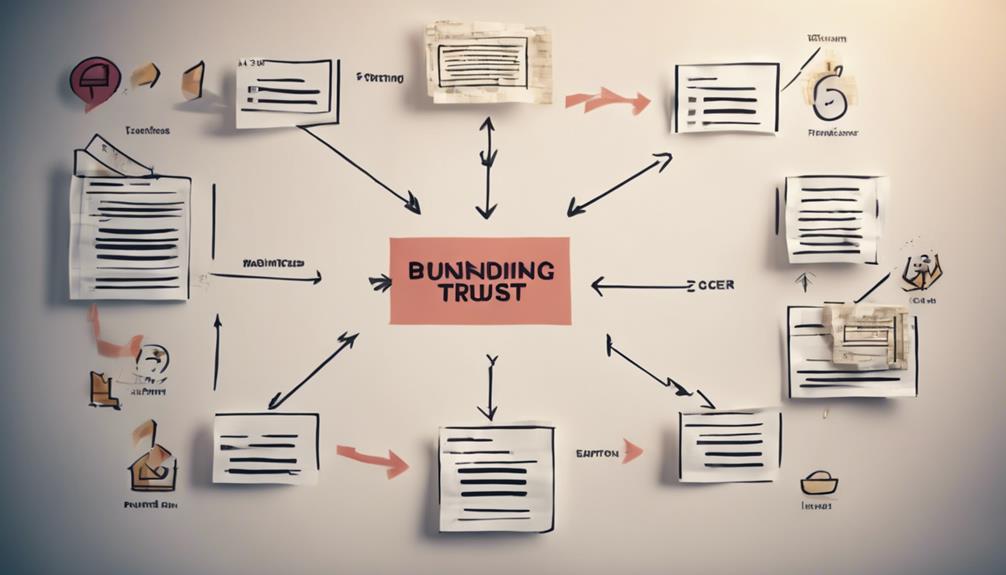A Step-by-Step Guide to How To Start a Business Trust
Are you ready to build a solid foundation for your business and protect your assets? Learning how to start a Business Trust may sound complex, but don’t worry! We’ve got you covered with a step-by-step guide that will make it a breeze.
From defining the purpose of your trust to choosing the right trustees and beneficiaries, every decision you make will shape its effectiveness and longevity. So, join us on this exciting journey and discover the key elements that will help you create a strong and successful Business Trust.
Let’s get started!
Understanding Business Trusts

When starting a business trust, it’s crucial to grasp the basics of how they operate and the process of forming one. Understanding the fundamental principles and steps involved will set you on the right path for creating a successful trust structure.
Business Trust Basics
In simple terms, a business trust is when someone gives control of their assets to another person called a trustee. The trustee then holds the rights to the person’s ownership in a business. This is all done through a legal document called a declaration of trust.
The declaration of trust explains what the trustee is responsible for, when and how the profits will be divided, and who’ll benefit from them. Just like a company can have many owners, a business trust can have one or more beneficiaries.
The trustee has a legal duty to act in the best interests of the beneficiaries. This means they’ve to make sure that the profits are divided up as the trust document says.
There are some advantages to setting up a business trust. One advantage is that it can protect the person’s assets from being taken if the business gets sued. Another advantage is that it can keep the person’s financial information more private.
But there are also some challenges to setting up a business trust. It can be expensive, and there are a lot of legal rules to follow. That’s why it’s important to work with a trust lawyer who can help. The average cost for a trust lawyer is around $500 per hour.
Trust Formation Process
When starting a business trust, there are important steps to follow. The first thing you need to do is create a document called a ‘declaration of trust.’ This document will give control of the trust’s assets to a person called a trustee. The declaration of trust will include important details about how the trust will work, such as what the trustee’s responsibilities are, when the trust’s profits will be distributed, and how the trust can be changed in the future.
A business trust is a good option because it offers liability protection, which means that the trust’s beneficiaries aren’t personally responsible for any debts or legal issues that the trust might have. The beneficiaries are the people who’ll benefit from the trust, and they can be one person or many. The trustee has a special duty to act in the best interests of the beneficiaries and is often paid a share of the trust’s profits.
Setting up a business trust requires careful thought and planning to make sure everything runs smoothly and the trust can grow. It’s a good idea to consult with legal professionals who can help you create a comprehensive declaration of trust that meets your goals and provides the protection and benefits you want. By following these steps, you can create a business trust that will protect your interests and benefit your chosen beneficiaries.
Types of Business Trusts
When starting a Business Trust, it’s essential to understand common trust structures and specialized trust variants.
Different types of business trusts, such as grantor trusts, simple trusts, and complex trusts, offer unique features and benefits.
Knowing the distinctions between these trust types will help you make informed decisions when setting up your business trust.
Common Trust Structures
When you’re thinking about setting up a Business Trust, it’s important to understand the different types of trust structures that are commonly used. These structures can help you manage your assets and decide how income is distributed within the trust.
One common type of trust is called a grantor trust. This trust is set up by the business owner and allows them to directly transfer income and assets to beneficiaries. It’s a straightforward way to distribute funds and resources.
Another type of trust is called a simple trust. With a simple trust, all income is distributed to beneficiaries on an annual basis. However, this type of trust doesn’t allow for charitable contributions.
If you’re looking for more flexibility in how income is managed and distributed, a complex trust may be the right choice for you. With a complex trust, you have the option to make charitable donations and accumulate income over time.
It’s important to note that each type of trust has its own set of rules and regulations. That’s why it’s a good idea to work with an estate planning attorney who can help you establish the terms of the trust and efficiently manage your trust funds. By doing so, you may be able to avoid probate processes and ensure that your assets are distributed according to your wishes.
Specialized Trust Variants
Let’s talk about some specialized trust options that are specifically designed for businesses. These include grantor trusts, simple trusts, and complex trusts. Each of these trusts has its own unique characteristics and purposes.
First, we’ve grantor trusts. These trusts are created by the person who’s establishing the trust, known as the grantor. Grantor trusts are often used for estate planning purposes and can be a great tool for managing real estate or other assets. With a grantor trust, the grantor retains control over the assets and can make changes to the trust as needed.
Next, we’ve simple trusts. Simple trusts are designed to distribute all of the income earned by the trust to the beneficiaries on an annual basis. This can be a good option for businesses that want to ensure regular income distribution to their beneficiaries. Simple trusts are often used for things like employee profit-sharing plans or other types of business arrangements.
Finally, we’ve complex trusts. Complex trusts are more flexible and can be used for a variety of purposes. With a complex trust, the income earned by the trust can either be accumulated within the trust or distributed in specific ways. This can be useful for businesses that have more intricate financial arrangements or want to plan for contingencies, such as the death of the grantor.
Benefits and Drawbacks

When considering starting a Business Trust, it’s essential to weigh the benefits and drawbacks. Business Trusts offer liability protection and privacy advantages but can also present challenges such as high costs and legal compliance requirements.
Understanding these pros and cons is crucial before proceeding with establishing a Business Trust.
Advantages of Business Trusts
Business Trusts offer some great benefits for business owners and beneficiaries. Let’s take a look at a few of them:
- Liability protection: One of the biggest advantages of a Business Trust is that it provides liability protection for your assets and business interests. This means that if something goes wrong and your business incurs debts or legal issues, your personal assets will be protected.
- Enhanced privacy: Business Trusts also offer enhanced privacy for business owners and beneficiaries. This means that your business affairs can be kept confidential, which can be important for many reasons, such as protecting your competitive advantage.
- Easy distribution of assets: Another advantage is that Business Trusts allow for easy distribution of assets according to the trust terms. This means that when it comes time to distribute the assets of the trust, it can be done quickly and efficiently.
- Similar to individual or family trusts: Business Trusts operate similarly to individual or family trusts, which means that there’s a fiduciary duty to act in the best interests of the beneficiaries. This can provide peace of mind knowing that your business interests are being managed by someone who’s a legal obligation to act in your best interests.
- Potential for beneficiary profits: Finally, Business Trusts can potentially benefit beneficiaries by receiving profits from the business. This means that if the business is doing well, the beneficiaries can receive a share of the profits, which can be a great financial advantage.
While Business Trusts have these advantages, it’s important to consider the drawbacks as well, such as the cost, complexity, and legal compliance involved. But overall, if you’re looking for liability protection, enhanced privacy, and easy asset distribution, a Business Trust could be a good option for you.
Challenges Facing Business Trusts
Starting and maintaining Business Trusts can be challenging, but it also has its benefits. Let’s take a closer look at the advantages and drawbacks for stakeholders.
One of the main benefits of Business Trusts is that they offer protection from liability. This means that if something goes wrong, the trust itself is responsible, not the individual stakeholders. Additionally, Business Trusts provide enhanced privacy, keeping sensitive information confidential.
However, there are also some drawbacks to consider. Establishing and managing a Business Trust can be costly, as there are legal hurdles to overcome and ongoing maintenance to take care of. It’s important to pay attention to details when setting up the trust and selecting trustees and beneficiaries. And as circumstances change, adjustments may need to be made.
Another challenge is the limited lifespan of Business Trusts, which can last up to 99 years. This can make long-term planning and sustainability difficult. Trustees have a fiduciary duty to prioritize the interests of beneficiaries and ensure proper profit distribution.
Initial Planning Steps
Before proceeding with establishing a Business Trust, you should define clear objectives for the trust and choose a trustee who aligns with your goals. These initial planning steps are crucial in ensuring the trust serves its intended purpose effectively.
Define Trust Objectives
To start planning for your Business Trust, it’s important to clearly state your specific objectives and goals for the trust. This will help you stay focused and ensure that everyone involved understands what you aim to achieve.
First, identify the key people who’ll be affected by the trust, such as stakeholders, beneficiaries, and intended recipients of the trust assets. This will help you determine who’ll benefit from the trust and guide your decision-making process.
Next, define the criteria and guidelines for how assets will be distributed to the beneficiaries. This will ensure fairness and transparency in the distribution process.
It is also important to establish a framework for decision-making and governance. This will help you effectively manage the trust’s operations and ensure that everyone involved has a voice in the decision-making process.
Consider the long-term vision and purpose of the trust. It should align with your business goals and values. This will help you create a cohesive strategy and ensure that the trust supports your overall mission.
Lastly, make sure that the objectives you set align with the overall mission and values of your business. This will ensure that the trust is integrated into your business strategy and contributes to your overall success.
Select Appropriate Trustee
Choosing the right trustee for your business trust is super important. You want someone who’s honest, knows what they’re doing, and is available when you need them. They should have experience in managing trusts and understand what your business wants to achieve. The trustee should also be willing to follow the rules of the trust and do what’s best for the people who’ll benefit from it. It’s really important that they can handle any conflicts of interest that might come up.
When picking a trustee, look for someone who can communicate well with the people who’ll benefit from the trust. They should be able to explain things clearly and do their job efficiently. By choosing a trustee with these qualities, you’ll be setting up your business trust for success. It will create trust between everyone involved and make sure that everyone’s best interests are taken care of. So take your time and choose wisely!
Drafting the Trust Document

When drafting the trust document, you’ll focus on:
- Identifying trust assets and selecting appropriate trustees.
- This crucial step sets the foundation for outlining rules, terms, and conditions within the business trust.
- By clearly defining roles, responsibilities, and distribution schedules, you ensure transparency and enforceability in managing the trust.
Identifying Trust Assets
When creating a business trust, it’s important to clearly identify and describe the assets that will be included. These assets can include a variety of things, such as real estate, investments, intellectual property, and more. Let’s take a closer look at each of these categories:
- Real Estate: This refers to any properties that will be included in the trust. It’s important to provide detailed information, including addresses and legal descriptions.
- Investments: If you have any investment accounts, such as stocks or bonds, they should be specified in the trust document. Include the names of the brokerage firms and the account numbers.
- Intellectual Property: If you have any patents, trademarks, or copyrights, it’s important to outline these rights in the trust document. This ensures that they’re protected and properly managed.
- Business Interests: If you have any ownership stakes or partnership shares in other businesses, be sure to include this information in the trust document. This helps clarify your business interests and ensures they’re handled according to your wishes.
- Other Valuable Assets: Don’t forget to include any other valuable assets, such as vehicles, equipment, or valuable collections. These items should be listed and described in the trust document.
Selecting Appropriate Trustees
Choosing the right trustees for your business trust is super important to keep things running smoothly. Trustees are the people who manage the trust’s money and make decisions that are in the best interest of the people who benefit from the trust. So it’s crucial to pick trustees who’ve good financial knowledge, are honest, and understand their responsibilities as trustees.
When you’re creating the trust document, be sure to clearly explain what the trustees can and can’t do. This will make things transparent and help everyone involved understand how the trust should be managed. You might want to consider hiring professionals like lawyers or financial advisors to be trustees. They’ve the expertise needed to handle the financial side of things.
But don’t forget about trusted individuals in your life who are responsible and can be relied on to handle the trust’s affairs. They could be great choices too.
It’s also a good idea to have a backup plan in case something happens to one of the trustees. This plan should outline what’ll happen if a trustee can no longer fulfill their duties, whether it’s because they’re sick or just can’t do it anymore. This way, the trust can keep going without any major interruptions.
Formalizing the Agreement
When formalizing the agreement for your business trust, it’s essential to focus on drafting trust documents that clearly outline the roles and responsibilities of the trustee, beneficiaries, and other parties involved.
Selecting the right trust parties and ensuring that the agreement includes provisions for asset management, distribution schedules, and decision-making processes are key aspects to consider.
Remember that periodic updates or amendments may be necessary to keep the trust document aligned with any changes in your business or the beneficiaries’ circumstances.
Drafting Trust Documents
So now that you’ve decided to create a trust, it’s time to take an important step: drafting trust documents. These documents are like a rulebook for your trust, outlining how it will be managed and how assets will be distributed. Here are some things to keep in mind when you’re drafting your trust documents.
First, you’ll need to specify the roles and responsibilities of the people involved in the trust. This includes the trustee, who’s in charge of managing the trust, and the beneficiaries, who’ll receive the trust assets. It’s important to be clear about who’s responsible for what.
Next, you’ll want to outline the purpose and objectives of the trust. This is important because it ensures that everyone understands why the trust is being created and what it’s meant to achieve. It also helps make sure that the trust is legally valid.
Seeking legal assistance is also crucial when drafting trust documents. Laws and regulations vary from state to state, so it’s important to make sure that your trust documents comply with the laws in your area. A lawyer can help guide you through this process and make sure everything is done correctly.
Your trust documents will serve as the foundation for your trust. They’ll guide how the trust is operated and administered. It’s important to make sure that they’re comprehensive and detailed, so that there’s no confusion or conflicts in the future.
Selecting Trust Parties
When you’re setting up a Business Trust, one of the most important things to do is choose the right trustee. This person or group will be responsible for managing the trust’s assets and following its rules. They’ve a special duty to act in the best interests of the trust and its beneficiaries. The trustee can be an individual, a group, or a company.
Speaking of beneficiaries, they’re the people who’ll benefit from the trust. They’re the ones who’ll receive the assets according to the trust’s terms. It’s important to clearly identify who these beneficiaries are.
To make everything official, a trust document is created. This document is like a contract that lays out the agreement between the person setting up the trust (known as the settlor), the trustee(s), and the beneficiaries. It’s important for all parties to understand and agree to the terms of the trust.
Communication is key in managing and distributing the trust’s assets. Everyone involved needs to be on the same page and understand the trust’s goals and objectives. The trustee must be capable and trustworthy, as they’ll be responsible for making important decisions about the trust’s assets.
Funding the Trust

Now it’s time to address funding the trust.
You need to identify trust assets and understand the asset transfer process to ensure the trust is properly funded.
Identifying Trust Assets
If you want to properly fund a Business Trust, it’s important to identify the different types of assets that can be included. These assets can include cash, real estate, investments, business interests, and personal property.
Cash is pretty straightforward – it’s money that you can transfer into the trust. Real estate refers to any property you own, such as land or buildings. Investments can include stocks, bonds, or any other financial assets that you have. Business interests could be shares or ownership stakes in a company. And personal property encompasses things like vehicles, jewelry, or any other valuable possessions.
Identifying these assets is crucial because it ensures that the trust has enough resources to function effectively. By transferring ownership of these assets to the trust, you’re protecting them and making sure they benefit the beneficiaries that you designate.
It’s also important to make sure that these assets are titled correctly. This means that the ownership is legally transferred to the trust. Properly titled assets are essential for the success of the trust because they allow the trustee to manage them in the best interests of the beneficiaries.
Asset Transfer Process
When you set up a Business Trust, it’s important to transfer your assets into the trust to ensure they’re managed and distributed according to the trust’s terms. This process involves changing the ownership of your assets to reflect the trust’s ownership.
To fund the trust, you’ll need to transfer assets such as real estate, investments, or business interests. This may require updating titles, deeds, or account registrations to show that the trust now owns these assets. By doing this, you can ensure that your assets are managed and distributed in line with the trust’s directives.
Properly funding the trust is crucial for maximizing the benefits of asset protection and estate planning. It helps to protect your assets and ensure that they’re distributed according to your wishes.
To transfer ownership smoothly, it’s important to follow the necessary steps diligently. This includes updating the necessary documents and registrations to reflect the trust ownership. By doing this, you can protect your assets within the trust framework and ensure that they’re managed and distributed effectively.
Managing and Amending the Trust
Managing and making changes to a Business Trust can be a complex task. However, by regularly reviewing the trust document, you can ensure that it aligns with your current intentions and goals.
Here are some important things to consider when managing and amending a Business Trust:
- Keep track of changes: It’s crucial to update the trust if there are any changes in beneficiaries, assets, or trustee selections. This will help ensure that the trust reflects the most up-to-date information.
- Seek professional advice: When making amendments to the trust, it’s wise to consult with legal and financial advisors. They can provide guidance and ensure that any changes comply with relevant laws and regulations.
- Document changes properly: It’s important to document all changes to the trust through formal amendments or restatements. This helps maintain clarity and validity, and provides a clear record of any modifications made.
- Communicate with beneficiaries: Transparency is key when it comes to managing a Business Trust. Keep beneficiaries informed about any amendments or changes to the trust. This will help maintain their trust and understanding of the trust’s provisions.
Conclusion
Great job on finishing this step-by-step guide to starting a business trust! Now you have all the knowledge you need to confidently navigate the process.
Remember to seek advice from experts, carefully create the trust terms, and stay informed about legal requirements. With attention to detail, you can successfully establish and manage a business trust to protect your interests and achieve your goals.
Good luck on your business trust journey! Have you ever considered starting a business trust? Share your thoughts and experiences below or explore more about this topic to deepen your understanding.





